Multidimensional Ecosystem Mapping: Towards a More Comprehensive Spatial Assessment of Nature’s Contributions to People in France
Abstract
1. Introduction
2. Comparative Analysis of Classification Schemes
2.1. Classification of Ecosystem Services (ESs) by Millennium Ecosystem Assessment
2.2. Classification of Ecosystem Services by TEEB
2.3. France National Ecosystem Service Assessment (France NEA)
2.4. Classification of Nature’s Contributions to People by IPBES (from [6])
2.5. Common International Classification of Ecosystem Services (CICES)
- (a)
- The provisioning of material and energy needs;
- (b)
- Regulation and maintenance of the environment for humans;
- (c)
- The non-material characteristics of ecosystems that affect the physical and mental states of people, that is, their cultural significance.
2.6. Conceptual Frameworks: Overlaps Dominating, but Relevant Differences
3. Indicator Development Methodology
3.1. Data and Processing
3.2. France as Study Area
4. ES/NCP Indicators and Maps
4.1. Indicators for Assessing Provisioning ESs/NCPs
4.2. Indicators for Assessing Regulating ESs/NCPs
4.3. Indicators for Assessing Cultural ESs/NCPs
5. Discussion and Conclusions
Discussion on Mapping Spatial Distribution of Ecosystem Services
Supplementary Materials
Author Contributions
Funding
Institutional Review Board Statement
Informed Consent Statement
Data Availability Statement
Conflicts of Interest
Appendix A
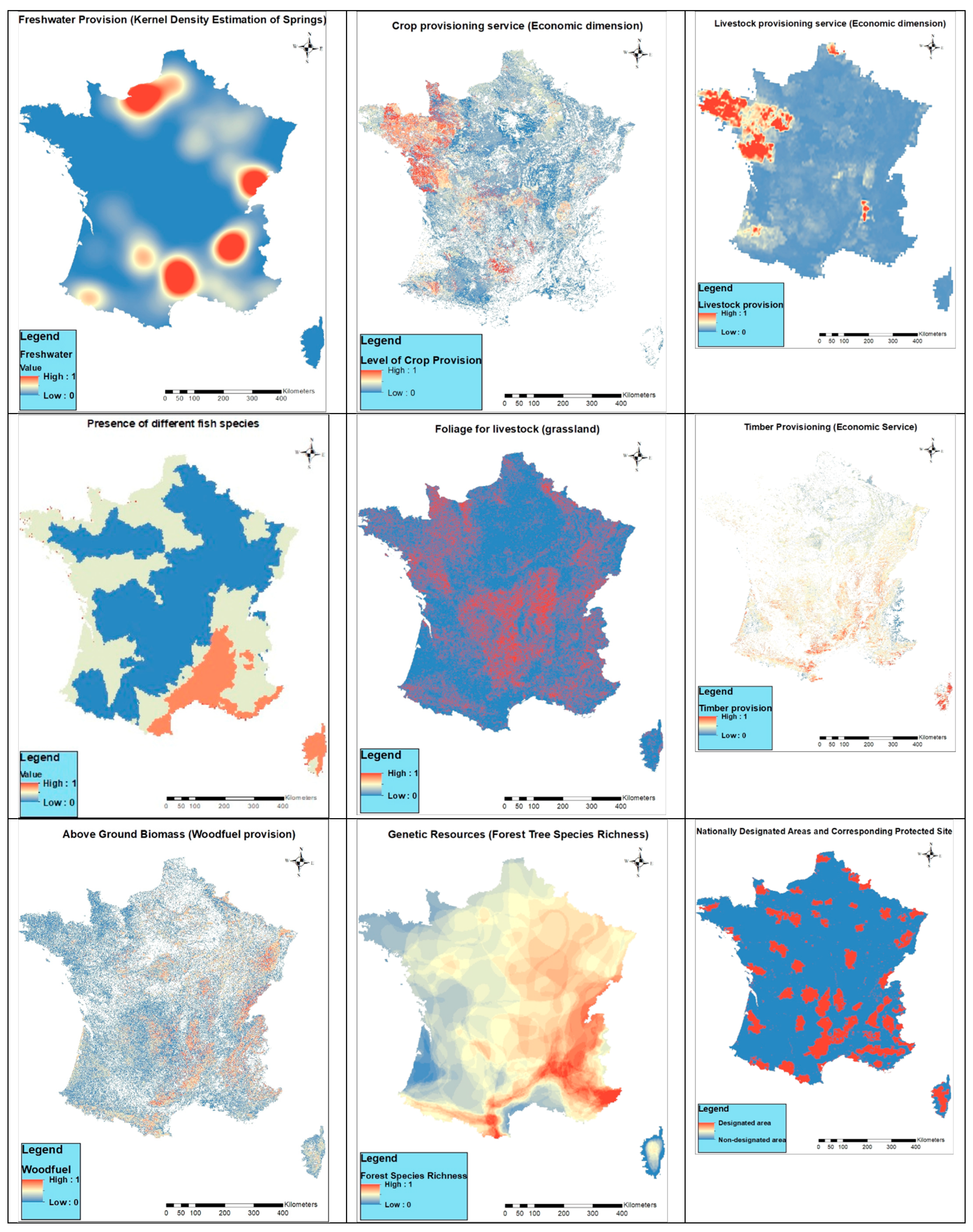

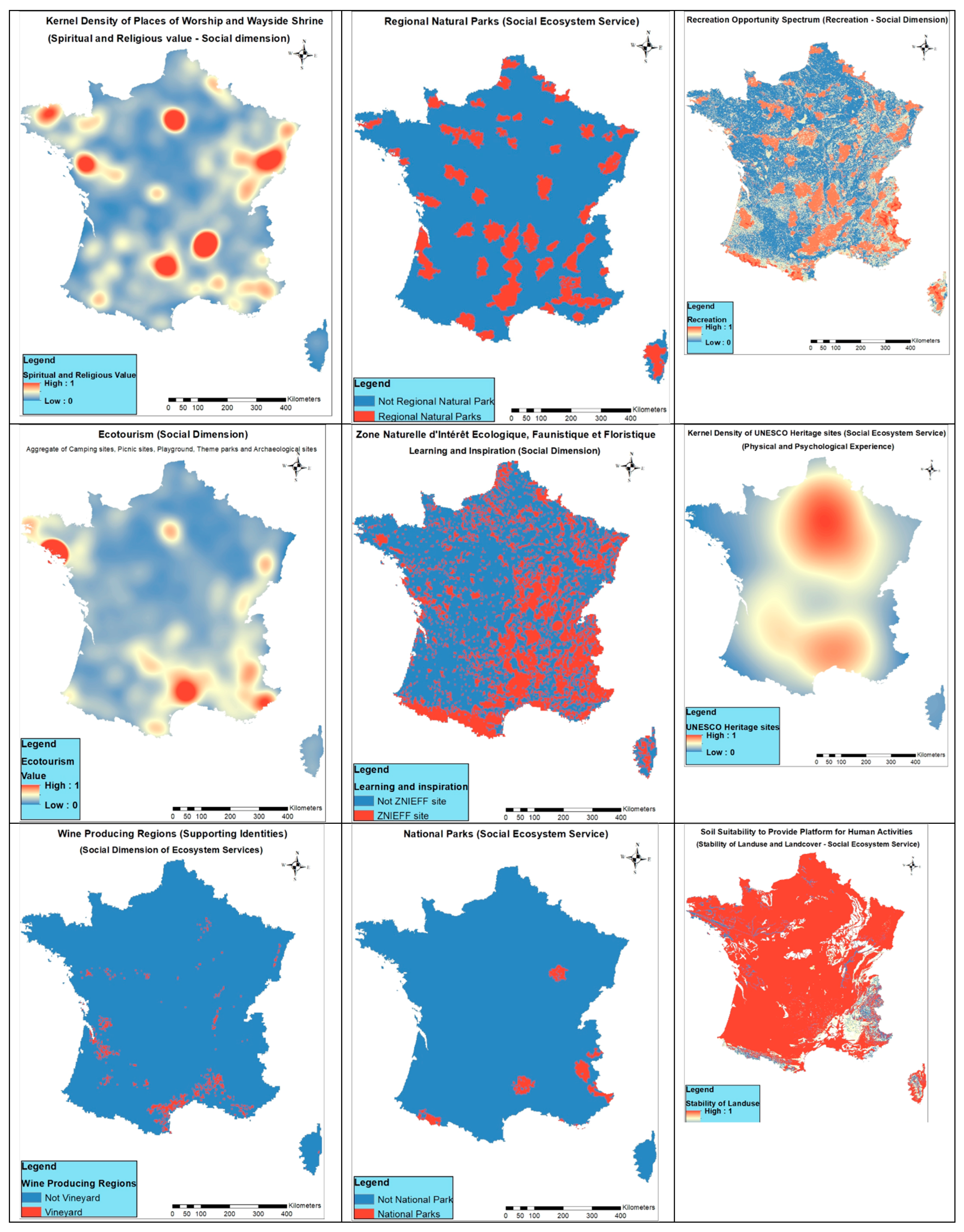
References
- Braat, L.C.; de Groot, R. The ecosystem services agenda: Bridging the worlds of natural science and economics, conservation and development, and public and private policy. Ecosyst. Serv. 2012, 1, 4–15. [Google Scholar] [CrossRef]
- De Groot, R.S.; Wilson, M.A.; Boumans, R.M. A typology for the classification, description and valuation of ecosystem functions, goods and services. Ecol. Econ. 2002, 41, 393–408. [Google Scholar] [CrossRef]
- Palmer, M.A.; Febria, C.M. The heartbeat of ecosystems. Science 2012, 336, 1393–1394. [Google Scholar] [CrossRef] [PubMed]
- IPBES Intergovernmental Science-Policy Platform on Biodiversity and Ecosystem Services. Methodological Assessment Report on the Diverse Values and Valuation of Nature of the Intergovernmental Science-Policy Platform on Biodiversity and Ecosystem Services. In Summary for Policymakers; Pascual, U., Balvanera, P., Christie, M., Baptiste, B., González-Jiménez, D., Anderson, C.B., Vatn, A., Eds.; IPBES: Bonn, Germany, 2022; p. 52. [Google Scholar] [CrossRef]
- IPBES Intergovernmental Science-Policy Platform on Biodiversity and Ecosystem Services. Preliminary guide regarding diverse conceptualization of multiple values of nature and its benefits, including biodiversity and ecosystem functions and services. In Proceedings of the Intergovernmental Science-Policy Platform on Biodiversity and Ecosystem Services, Fourth Session, Kuala Lumpur, Malaysia, 22–28 February 2016; IPBES: Bonn, Germany, 2015. [Google Scholar]
- IPBES Intergovernmental Science-Policy Platform on Biodiversity and Ecosystem Services. Global Assessment Report on Biodiversity and Ecosystem Services of the Intergovernmental Science-Policy Platform on Biodiversity and Ecosystem Services; Brondizio, E.S., Settele, J., Díaz, S., Ngo, H.T., Eds.; IPBES: Bonn, Germany, 2019. [Google Scholar]
- WWF. Living Planet Report 2020—Bending the Curve of Biodiversity Loss; Almond, R.E.A., Grooten, M., Petersen, T., Eds.; WWF: Gland, Switzerland, 2020. [Google Scholar]
- IPBES Intergovernmental Science-Policy Platform on Biodiversity and Ecosystem Services. Workshop Report on Biodiversity and Pandemics; Daszak, P., Amuasi, J., das Neves, C.G., Hayman, D., Kuiken, T., Roche, B., Zambrana-Torrelio, C., Buss, P., Dundarova, H., Feferholtz, Y., Eds.; IPBES: Bonn, Germany, 2020. [Google Scholar] [CrossRef]
- Shmelev, S.E. Ecosystems: Complexity, Diversity and Nature’s Contribution to Humanity (with Text by Joachim, H. Spangenberg); Environment Europe Press: Hague, The Netherlands, 2018; 302p. [Google Scholar]
- UNEP; Schandl, H.; Fischer-Kowalski, M.; West, J.; Giljum, S.; Dittrich, M.; Eisenmenger, N.; Geschke, A.; Lieber, M.; Wieland, H.P.; et al. Global Material Flows and Resource Productivity. An Assessment Study of the UNEP International Resource Panel; United Nations Environment Programme: Paris, France, 2016. [Google Scholar]
- UNEP IRP, United Nations Environment Programme International Resource Panel; Oberle, B.; Bringezu, S.; Hatfeld-Dodds, S.; Hellweg, S.; Schandl, H.; Clement, J.; Cabernard, L.; Che, N.; Chen, D.; et al. Global Resources Outlook 2019: Natural Resources for the Future We Want; IRP Reports; UNEP United Nations Environment Programme: Nairobi, Kenya, 2019; p. 162. [Google Scholar]
- Lenzen, M.; Moran, D.; Kanemoto, K.; Foran, B.; Lobefaro, L.; Geschke, A. International trade drives biodiversity threats in developing nations. Nature 2012, 486, 109–112. [Google Scholar] [CrossRef] [PubMed]
- Bowles, N.; Alexander, S.; Hadjikakou, M. The livestock sector and planetary boundaries: A ‘limits to growth’ perspective with dietary implications. Ecol. Econ. 2019, 160, 128–136. [Google Scholar] [CrossRef]
- Steffen, W.; Richardson, K.; Rockström, J.; Cornell, S.E.; Fetzer, I.; Bennett, E.M.; Biggs, R.; Carpenter, S.R.; de Vries, W.; de Wit, C.A.; et al. Planetary boundaries: Guiding human development on a changing planet. Science 2015, 347, 1259855. [Google Scholar] [CrossRef]
- Sukhdev, P.; Wittmer, H.; Schröter-Schlaack, C.; Nesshöver, C.; Bishop, J.; Brink, P.T.; Simmons, B. The Economics of Ecosystems and Biodiversity: Mainstreaming the Economics of Nature: A Synthesis of the Approach, Conclusions and Recommendations of TEEB (No. 333.95 E19); UNEP: Geneva, Switzerland, 2010. [Google Scholar]
- TEEB. The Economics of Ecosystems and Biodiversity Ecological and Economic Foundations; Kumar, P., Ed.; Earthscan: London, UK; Washington, DC, USA, 2010. [Google Scholar]
- DesRoches, T.C. What Is Natural about Natural Capital during the Anthropocene? Sustainability 2018, 10, 806. [Google Scholar] [CrossRef]
- Missemer, A. Natural Capital as an Economic Concept, History and Contemporary Issues. Ecol. Econ. 2018, 143, 90–96. [Google Scholar] [CrossRef]
- Spangenberg, J.H.; Settele, J. Precisely incorrect? Monetising the value of ecosystem services. Ecol. Complex. 2010, 7, 327–337. [Google Scholar] [CrossRef]
- Gunton, R.M.; Marsh, C.J.; Moulherat, S.; Malchow, A.-K.; Bocedi, G.; Klenke, R.A.; Kunin, W.E. Multicriterion trade-offs and synergies for spatial conservation planning. J. Appl. Ecol. 2016, 54, 903–913. [Google Scholar] [CrossRef]
- Small, N.; Munday, M.; Durance, I. The challenge of valuing ecosystem services that have no material benefits. Glob. Environ. Change 2017, 44, 57–67. [Google Scholar] [CrossRef]
- Spangenberg, J.H.; Settele, J. Value pluralism and economic valuation—Defendable if well done. Ecosyst. Serv. 2016, 18, 100–109. [Google Scholar] [CrossRef]
- Costanza, R.; Kubiszewski, I.; Stoeckl, N.; Kompas, T. Pluralistic discounting recognizing different capital contributions: An example estimating the net present value of global ecosystem services. Ecol. Econ. 2021, 183, 106961. [Google Scholar] [CrossRef]
- United Nations. System of Environmental-Economic Accounting—Ecosystem Accounting (SEEA EA); United Nations: New York, NY, USA, 2021. [Google Scholar]
- Ruckelshaus, M.; McKenzie, E.; Tallis, H.; Guerry, A.; Daily, G.; Kareiva, P.; Polasky, S.; Ricketts, T.; Bhagabati, N.; Wood, S.A.; et al. Notes from the field: Lessons learned from using ecosystem service approaches to inform real-world decisions. Ecol. Econ. 2015, 115, 11–21. [Google Scholar] [CrossRef]
- Spangenberg, J.H. Indicators for Sustainable Development. In Routledge International Handbook of Sustainable Development; Redclift, M., Springett, D., Eds.; Routledge: Abingdon, UK, 2015; Chapter 20; pp. 308–322. [Google Scholar]
- Tammi, I.; Mustajärvi, K.; Rasinmäki, J. Integrating spatial valuation of ecosystem services into regional planning and development. Ecosyst. Serv. 2017, 26, 329–344. [Google Scholar] [CrossRef]
- Willcock, S.; Martinez-Lopez, J.; Dandy, N.; Bullock, J.M. High Spatial-Temporal Resolution Data across Large Scales Are Needed to Transform Our Understanding of Ecosystem Services. Land 2021, 10, 759. [Google Scholar] [CrossRef]
- Millennium Ecosystem Assessment. Ecosystems and Human Well-being; Island Press: Washington, DC, USA, 2005. [Google Scholar]
- Mace, G.M.; Bateman, I.; Albon, S.; Balmford, A.; Brown, C.; Church, A.; Haines-Young, R.; Pretty, J.N.; Turner, K.; Vira, B.; et al. Chapter 2: Conceptual framework and methodology. In United Kingdom National Ecosystem Assessment: Technical Report; UNEP-WCMC: Cambridge, UK, 2011; pp. 12–26. [Google Scholar]
- Díaz, S.; Pascual, U.; Stenseke, M.; Martín-López, B.; Watson, R.T.; Molnár, Z.; Hill, R.; Chan, K.M.A.; Baste, I.A.; Brauman, K.A.; et al. Assessing nature’s contributions to people. Science 2018, 359, 270–272. [Google Scholar] [CrossRef]
- Dasgupta, P. The Economics of Biodiversity: The Dasgupta Review; HM Treasury: London, UK, 2021. [Google Scholar]
- Mandle, L.; Shields-Estrada, A.; Chaplin-Kramer, R.; Mitchell, M.G.E.; Bremer, L.L.; Gourevitch, J.D.; Hawthorne, P.; Johnson, J.A.; Robinson, B.E.; Smith, J.R.; et al. Increasing decision relevance of ecosystem service science. Nat. Sustain. 2020, 4, 161–169. [Google Scholar] [CrossRef]
- CICES. Towards a Common International Classification for Ecosystem Service v.4.3. 2013. Available online: http://cices.eu/resources/ (accessed on 15 January 2021).
- Shmelev, S.E. Multi-Criteria Assessment of Ecosystems and Biodiversity: New Dimensions and Stakeholders in the South of France; University of Oxford, Department of International Development: Oxford, UK, 2010. [Google Scholar]
- Shmelev, S.E. Economic Valuation and Decision Making: MCDA as a Tool for the Future. In Ecological Economics; Springer: Dordrecht, The Netherlands, 2012; pp. 57–74. [Google Scholar]
- Benayas, J.M.R.; Newton, A.C.; Diaz, A.; Bullock, J.M. Enhancement of biodiversity and ecosystem services by ecological restoration: A meta-analysis. Science 2009, 325, 1121–1124. [Google Scholar] [CrossRef]
- Rolando, J.L.; Turin, C.; Ramírez, D.A.; Mares, V.; Monerris, J.; Quiroz, R. Key ecosystem services and ecological intensification of agriculture in the tropical high-Andean Puna as affected by land-use and climate changes. Agric. Ecosyst. Environ. 2017, 236, 221–233. [Google Scholar] [CrossRef]
- Harrison, P.A.; Berry, P.M.; Simpson, G.; Haslett, J.R.; Blicharska, M.; Bucur, M.; Dunford, R.; Egoh, B.; Garcia-Llorente, M.; Geamănă, N.; et al. Linkages between biodiversity attributes and ecosystem services: A systematic review. Ecosyst. Serv. 2014, 9, 191–203. [Google Scholar] [CrossRef]
- Darvill, R.; Lindo, Z. The inclusion of stakeholders and cultural ecosystem services in land management trade-off decisions using an ecosystem services approach. Landsc. Ecol. 2016, 31, 533–545. [Google Scholar] [CrossRef]
- Fisher, B.; Turner, R.K.; Morling, P. Defining and classifying ecosystem services for decision making. Ecol. Econ. 2009, 68, 643–653. [Google Scholar] [CrossRef]
- Olson, K.R.; Morton, L.W. Managing the upper Missouri River for agriculture irrigation, flood control, and energy. J. Soil Water Conserv. 2017, 72, 105A–110A. [Google Scholar] [CrossRef]
- Martinez-Alier, J.; Munda, G.; O’Neill, J. Weak comparability of values as a foundation for ecological economics. Ecol. Econ. 1998, 26, 277–286. [Google Scholar] [CrossRef]
- Norgaard, R. Ecosystem services: From eye-opening metaphor to complexity blinder. Ecol. Econ. 2010, 69, 1219–1227. [Google Scholar] [CrossRef]
- Söderbaum, P. Ecological economics in relation to democracy, ideology and politics. Ecol. Econ. 2013, 95, 221–225. [Google Scholar] [CrossRef]
- Gomez-Baggethun, E.; de Groot, R.; Lomas, P.L.; Montes, C. The history of ecosystem services in economic theory and practice: From early notions to markets and payment schemes. Ecol. Econ. 2010, 69, 1209–1218. [Google Scholar] [CrossRef]
- Gowdy, J.; Rosser, J.B., Jr.; Roy, L. The evolution of hyperbolic discounting: Implications for truly social valuation of the future. J. Econ. Behav. Organ. 2013, 90, S94–S104. [Google Scholar] [CrossRef]
- Nordhaus, W. Critical Assumptions in the Stern Review on Climate Change. Science 2007, 317, 201–202. [Google Scholar] [CrossRef]
- Smith, K. Discounting, Risk and Uncertainty in Economic Appraisals of Climate Change Policy: Comparing Nordhaus, Garnaut and Stern; Citeseer: Canberra, NS, Australia, 2011. [Google Scholar]
- EFESE. Cadre Conceptuel. 2017. Available online: https://ree.developpement-durable.gouv.fr/themes/defis-environnementaux/erosion-de-la-biodiversite/evaluations-mondiales-et-nationales/article/l-evaluation-francaise-des-ecosystemes-et-des-services-ecosystemiques-efese (accessed on 21 December 2020).
- Maes, J.; Teller, A.; Erhard, M.; Liquete, C.; Braat, L.; Berry, P.; Santos-Martín, F. Mapping and Assessment of Ecosystems and Their Services—An Analytical Framework for Ecosystem Assessments under Action 5 of the EU Biodiversity Strategy to 2020; EU Joint Research Centre, JCR Policy Reports: Luxembourg, 2015. [Google Scholar]
- Haines-Young, R.; Potschin, M.B. Common international classification of ecosystem services (CICES, Version 4.1). Eur. Environ. Agency 2012, 33, 107. [Google Scholar]
- Haines-Young, R.; Potschin, M.B. Common International Classification of Ecosystem Services (CICES) V5.1 and Guidance on the Application of the Revised Structure. 2018. Available online: https://cices.eu/ (accessed on 20 April 2021).
- EEA European Environment Agency. CICES—Towards a Common Classification of Ecosystem Services. Hosted on Behalf of the EEA. 2023. Available online: https://cices.eu/cices-structure/ (accessed on 15 January 2021).
- Spangenberg, J.H. Sustainability and the Challenge of Complex Systems. In Theories of Sustainable Development; Routledge Studies in Sustainable Development Series, Enders, J.C., Remig, M., Eds.; Routledge: Abingdon, UK, 2015; pp. 89–111. [Google Scholar]
- Sustainable Seattle. The Sustainable Seattle 1993 Indicators of A Sustainable Community. 1993. Available online: https://communityindicators.net/resources/sustainable-seattles-indicators-or-sustainable-community/ (accessed on 15 January 2021).
- European Commission Joint Research Centre. Available online: https://joint-research-centre.ec.europa.eu/index_en (accessed on 15 January 2021).
- European Soil Data Centre. Available online: https://esdac.jrc.ec.europa.eu/ (accessed on 15 January 2021).
- Harvard Dataverse. Available online: https://data.harvard.edu/dataverse (accessed on 15 January 2021).
- Open Street Maps. Available online: https://www.openstreetmap.org/#map=6/51.330/10.453 (accessed on 15 January 2021).
- Castro, A.J.; Martín-López, B.; López, E.; Plieninger, T.; Alcaraz-Segura, D.; Vaughn, C.C.; Cabello, J. Do protected areas networks ensure the supply of ecosystem services? Spatial patterns of two nature reserve systems in semi-arid Spain. Appl. Geogr. 2015, 60, 1–9. [Google Scholar] [CrossRef]
- Mokondoko, P.; Manson, R.H.; Ricketts, T.H.; Geissert, D. Spatial analysis of ecosystem service relationships to improve targeting of payments for hydrological services. PLoS ONE 2018, 13, e0192560. [Google Scholar] [CrossRef] [PubMed]
- Maes, J.; Paracchini, M.L.; Zulian, G.; Dunbar, M.B.; Alkemade, R. Synergies and trade-offs between ecosystem service supply, biodiversity, and habitat conservation status in Europe. Biol. Conserv. 2012, 155, 1–12. [Google Scholar] [CrossRef]
- Lenormand, M.; Papuga, G.; Argagnon, O.; Soubeyrand, M.; De Barros, G.; Alleaume, S.; Luque, S. Biogeographical network analysis of plant species distribution in the Mediterranean region. Ecol. Evol. 2019, 9, 237–250. [Google Scholar] [CrossRef]
- Wilson, J.E. Terroir: The Role of Geology, Climate and Culture in the Making of French Wines; University of California Press: Oakland, CA, USA, 1998. [Google Scholar]
- Bachrach, B.S.; Blondel, J.F.P.; Popkin, J.D.; Woloch, I.; Weber, E.; Bernard, F.; Bisson, T.N.; Drinkwater, J.F.; Shennan, J.H.; Flower, J.E.; et al. France. Encyclopedia Britannica. 2021. Available online: https://www.britannica.com/place/France (accessed on 7 January 2021).
- France.fr. Geography and Climate. 2020. Available online: https://www.france.fr/en/holiday-prep/geography-and-climate (accessed on 20 December 2020).
- Sargeant, C.I.; Singer, M.B. Subannual variability in historical water source use by Mediterranean riparian trees. Ecohydrology 2016, 9, 1328–1345. [Google Scholar] [CrossRef]
- Hickler, T.; Vohland, K.; Feehan, J.; Miller, P.A.; Smith, B.; Costa, L.; Giesecke, T.; Fronzek, S.; Carter, T.R.; Cramer, W.; et al. Projecting the future distribution of European potential natural vegetation zones with a generalized, tree species-based dynamic vegetation model. Glob. Ecol. Biogeogr. 2012, 21, 50–63. [Google Scholar] [CrossRef]
- Balmford, A.; Rodrigues, S.I.; Walpole, M.; Ten Brink, P.; Kettunen, M.; Braat, L.; De Groot, R.S. The Economics of Biodiversity and Ecosystems: Scoping the Science; European Commission: Brussels, Belgium, 2008. [Google Scholar]
- Church, A.; Fish, R.; Haines-Young, R.; Mourato, S.; Tratalos, J.; Stapleton, L.; Willis, C. UK National Ecosystem Assessment Follow-on: Cultural Ecosystem Services and Indicators; UNEP-WCMC: Cambridge, UK, 2014. [Google Scholar]
- Naidoo, R.; Balmford, A.; Costanza, R.; Fisher, B.; Green, R.E.; Lehner, B.; Malcolm, T.R.; Ricketts, T.H. Global mapping of ecosystem services and conservation priorities. Proc. Natl. Acad. Sci. USA 2008, 105, 9495–9500. [Google Scholar] [CrossRef]
- Crouzat, E.; Mouchet, M.; Turkelboom, F.; Byczek, C.; Meersmans, J.; Berger, F.; Lavorel, S. Assessing bundles of ecosystem services from regional to landscape scale: Insights from the French Alps. J. Appl. Ecol. 2015, 52, 1145–1155. [Google Scholar] [CrossRef]
- Le Clec’h, S.; Finger, R.; Buchmann, N.; Gosal, A.S.; Hörtnagl, L.; Huguenin-Elie, O.; Jeanneret, P.; Lüscher, A.; Schneider, M.K.; Huber, R. Assessment of spatial variability of multiple ecosystem services in grasslands of different intensities. J. Environ. Manag. 2019, 251, 109372. [Google Scholar] [CrossRef]
- Chan, K.M.; Shaw, M.R.; Cameron, D.R.; Underwood, E.C.; Daily, G.C. Conservation planning for ecosystem services. PLoS Biol. 2006, 4, e379. [Google Scholar] [CrossRef] [PubMed]
- Mace, G.M.; Baillie, J.E. The 2010 biodiversity indicators: Challenges for science and policy. Conserv. Biol. 2007, 21, 1406–1413. [Google Scholar] [CrossRef] [PubMed]
- Mills, M.B.; Malhi, Y.; Ewers, R.M.; Kho, L.K.; Teh, Y.A.; Both, S.; Burslem, D.F.R.P.; Majalap, N.; Nilus, R.; Huasco, W.H.; et al. Tropical forests post-logging are a persistent net carbon source to the atmosphere. Proc. Natl. Acad. Sci. USA 2023, 120, e2214462120. [Google Scholar] [CrossRef]
- Bertrand, M.; Barot, S.; Blouin, M.; Whalen, J.; de Oliveira, T.; Roger-Estrade, J. Earthworm services for cropping systems. A review. Agron. Sustain. Dev. 2015, 35, 553–567. [Google Scholar] [CrossRef]
- Ojha, R.B.; Devkota, D. Earthworms: Soil and ecosystem engineers—A review. World J. Agric. Res. 2014, 2, 257–260. [Google Scholar] [CrossRef]
- Banwart, S.A.; Noellemeyer, E.; Milne, E. (Eds.) Soil Carbon: Science, Management and Policy for Multiple Benefits; CABI: Wallingford, UK, 2014; Volume 71. [Google Scholar]
- Schröder, J.J.; Schulte, R.P.O.; Creamer, R.E.; Delgado, A.; van Leeuwen, J.; Lehtinen, T.; Rutgers, M.; Spiegel, H.; Staes, J.; Tóth, G.; et al. The elusive role of soil quality in nutrient cycling: A review. Soil Use Manag. 2016, 32, 476–486. [Google Scholar] [CrossRef]
- Ayangbenro, A.S.; Babalola, O.O. A new strategy for heavy metal polluted environments: A review of microbial biosorbents. Int. J. Environ. Res. Public Health 2017, 14, 94. [Google Scholar] [CrossRef]
- Sherameti, I.; Varma, A. Heavy Metal Contamination of Soils; Springer: Berlin/Heidelberg, Germany, 2015. [Google Scholar]
- Wuana, R.A.; Okieimen, F.E. Heavy Metals in Contaminated Soils: A Review of Sources, Chemistry, Risks and Best Available Strategies for Remediation. ISRN Ecol. 2011, 2011, 402647. [Google Scholar] [CrossRef]
- Wood, M.D.; Kumar, P.; Negandhi, D.; Verma, M. Guidance Manual for the Valuation of Regulating Services; UNEP: Liverpool, UK, 2010. [Google Scholar]
- Reyers, B.; O’Farrell, P.J.; Cowling, R.M.; Egoh, B.N.; Le Maitre, D.C.; Vlok, J.H. Ecosystem services, land-cover change, and stakeholders: Finding a sustainable foothold for a semiarid biodiversity hotspot. Ecol. Soc. 2009, 14, 38. [Google Scholar] [CrossRef]
- Mitsch, W.J.; Bernal, B.; Hernandez, M.E. Ecosystem services of wetlands. Int. J. Biodivers. Sci. Ecosyst. Serv. Manag. 2015, 11, 1–4. [Google Scholar] [CrossRef]
- Dordio, A.; Palace, A.J.; Pinto, A.P. Wetlands: Water Living Filters? Nova Science Publishers: Hauppauge, NY, USA, 2008. [Google Scholar]
- Moleon, M.; Sanchez-Zapata, J.A.; Margalida, A.; Carrete, M.; Owen-Smith, N.; Donazar, J.A. Humans and scavengers: The evolution of interactions and ecosystem services. BioScience 2014, 64, 394–403. [Google Scholar] [CrossRef]
- Perfecto, I.; Vandermeer, J. The effect of an ant-hemipteran mutualism on the coffee berry borer (Hypothenemus hampei) in Southern Mexico. Agric. Ecosyst. Environ. 2006, 117, 218–221. [Google Scholar] [CrossRef]
- Sutter, L.; Albrecht, M. Synergistic interactions of ecosystem services: Florivorous pest control boosts crop yield increase through insect pollination. Proc. R. Soc. B Biol. Sci. 2016, 283, 20152529. [Google Scholar] [CrossRef]
- Anjos, D.V.; Tena, A.; Viana-Junior, A.B.; Carvalho, R.L.; Torezan-Silingardi, H.; Del-Claro, K.; Perfecto, I. The effects of ants on pest control: A meta-analysis. Proc. R. Soc. B Biol. Sci. 2022, 289, 20221316. [Google Scholar] [CrossRef] [PubMed]
- DeLong, J.P.; Uiterwaal, S.F. Predator functional responses and the biocontrol of aphids and mites. BioControl 2022, 67, 161–172. [Google Scholar] [CrossRef]
- Karp, D.S.; Daily, G.C. Cascading effects of insectivorous birds and bats in tropical coffee plantations. Ecology 2014, 95, 1065–1074. [Google Scholar] [CrossRef]
- Maas, B.; Clough, Y.; Tscharntke, T. Bats and birds increase crop yield in tropical agroforestry landscapes. Ecol. Lett. 2013, 16, 1480–1487. [Google Scholar] [CrossRef]
- Williams-Guillén, K.; Perfecto, I. Effects of agricultural intensification on the assemblage of leaf-nosed bats (Phyllostomidae) in a coffee landscape in Chiapas, Mexico. Biotropica 2010, 42, 605–613. [Google Scholar] [CrossRef]
- Morand, S.; Lajaunie, C. Outbreaks of Vector-Borne and Zoonotic Diseases Are Associated with Changes in Forest Cover and Oil Palm Expansion at Global Scale. Front. Vet. Sci. 2021, 8, 661063. [Google Scholar] [CrossRef]
- Bagstad, K.J.; Villa, F.; Batker, D.; Harrison-Cox, J.; Voigt, B.; Johnson, G.W. From theoretical to actual ecosystem services: Mapping beneficiaries and spatial flows in ecosystem service assessments. Ecol. Soc. 2014, 19, 64. [Google Scholar] [CrossRef]
- McConnell, V.; Walls, M.A. The Value of Open Space: Evidence from Studies of Nonmarket Benefits; Resources for the Future: Washington, DC, USA, 2005; pp. 1–78. [Google Scholar]
- Blicharska, M.; Mikusiński, G. Incorporating social and cultural significance of large old trees in conservation policy. Conserv. Biol. 2014, 28, 1558–1567. [Google Scholar] [CrossRef] [PubMed]
- Kati, V.; Hovardas, T.; Dieterich, M.; Ibisch, P.L.; Mihok, B.; Selva, N. The challenge of implementing the European network of protected areas Natura 2000. Conserv. Biol. 2015, 29, 260–270. [Google Scholar] [CrossRef]
- Vlami, V.; Kokkoris, I.P.; Zogaris, S.; Cartalis, C.; Kehayias, G.; Dimopoulos, P. Cultural landscapes and attributes of “culturalness” in protected areas: An exploratory assessment in Greece. Sci. Total Environ. 2017, 595, 229–243. [Google Scholar] [CrossRef] [PubMed]
- Vlami, V.; Kokkoris, I.P.; Zogaris, S.; Kehayias, G.; Dimopoulos, P. Cultural Ecosystem Services in the Natura 2000 Network: Introducing Proxy Indicators and Conflict Risk in Greece. Land 2020, 10, 4. [Google Scholar] [CrossRef]
- Winkler, K.J.; Viers, J.H.; Nicholas, K.A. Assessing ecosystem services and multifunctionality for vineyard systems. Front. Environ. Sci. 2017, 5, 15. [Google Scholar] [CrossRef]
- Beckert, J.; Rössel, J.; Schenk, P. Wine as a cultural product: Symbolic capital and price formation in the wine field. Sociol. Perspect. 2017, 60, 206–222. [Google Scholar] [CrossRef]
- Winkler, K.J.; Nicholas, K.A. More than wine: Cultural ecosystem services in vineyard landscapes in England and California. Ecol. Econ. 2016, 124, 86–98. [Google Scholar] [CrossRef]
- Orre-Gordon, S.; Jacometti, M.; Tompkins, J.; Wratten, S.D. Viticulture can be modified to provide multiple ecosystem services. In Ecosystem Services in Agricultural and Urban Landscapes; Wiley: Hoboken, NJ, USA, 2013; pp. 43–57. [Google Scholar]
- Trubek, A.B. The Taste of Place: A Cultural Journey into Terroir; University of California Press: Oakland, CA, USA, 2008; Volume 20. [Google Scholar]
- UNESCO. World Heritage List. 2016. Available online: http://whc.unesco.org/en/list (accessed on 20 July 2016).
- Campbell, C.; Granett, J. Books and arts-Phylloxera: How Wine was Saved for the World? Nature 2004, 428, 20. [Google Scholar]
- Polasky, S.; Nelson, E.; Camm, J.; Csuti, B.; Fackler, P.; Lonsdorf, E.; Montgomery, C.; White, D.; Arthur, J.; Garber-Yonts, B.; et al. Where to put things? Spatial land management to sustain biodiversity and economic returns. Biol. Conserv. 2008, 141, 1505–1524. [Google Scholar] [CrossRef]
- Nicholas, K.A.; Durham, W.H. Farm-scale adaptation and vulnerability to environmental stresses: Insights from winegrowing in Northern California. Glob. Environ. Change 2012, 22, 483–494. [Google Scholar] [CrossRef]
- Dias, C.; Mendes, L. Protected designation of origin (PDO), protected geographical indication (PGI) and traditional speciality guaranteed (TSG): A bibiliometric analysis. Food Res. Int. 2018, 103, 492–508. [Google Scholar] [CrossRef] [PubMed]
- Fran, B. The Social Life of Cheese. 2019. Available online: https://hraf.yale.edu/the-social-life-of-cheese/ (accessed on 30 December 2020).
- Grasseni, C. Re-inventing food: Alpine cheese in the age of global heritage. Anthropol. Food 2011, 8. [Google Scholar] [CrossRef]
- European Commission. Directive (EU) 2022/2464 of the European Parliament and of the Council of 14 December 2022 amending Regulation (EU) No 537/2014, Directive 2004/109/EC, Directive 2006/43/EC and Directive 2013/34/EU, as Regards Corporate Sustainability Reporting; European Commission: Brussels, Belgium, 2022. [Google Scholar]
- Vallecillo, S. INCA—Crop Provision—ES Flow—2012; European Commission, Joint Research Centre (JRC): Brussels, Belgium, 2018. [Google Scholar]
- Gilbert, M.; Nicolas, G.; Cinardi, G.; Van Boeckel, T.P.; Vanwambeke, S.O.; Wint, G.W.; Robinson, T.P. Global distribution data for cattle, buffaloes, horses, sheep, goats, pigs, chickens and ducks in 2010. Sci. Data 2018, 5, 1–11. [Google Scholar] [CrossRef] [PubMed]
- Rob, L. Global Wilderness; UNEP-WCMC: Cambridge, UK, 1998. [Google Scholar]
- Vallecillo, S. INCA—Timber Provision—ES Flow—2012; European Commission, Joint Research Centre (JRC): Brussels, Belgium, 2019. [Google Scholar]
- Santoro, M.; Cartus, O.; Mermoz, S.; Bouvet, A.; Le Toan, T.; Carvalhais, N.; Seifert, F.M. GlobBiomass Global Above-Ground Biomass and Growing Stock Volume Datasets; Technical Report; GlobBiomass: Jena, Germany, 2018; Available online: http://globbiomass.org/products/global-mapping (accessed on 28 April 2020).
- Caudullo, G.; Welk, E.; San-Miguel-Ayanz, J. Chorological maps for the main European woody species: Supplementary material. Data Brief 2017, 12, 662–666. [Google Scholar] [CrossRef] [PubMed]
- Hoekstra, J.M.; Molnar, J.L.; Jennings, M.; Revenga, C. The Atlas of Global Conservation: Changes, Challenges and Opportunities to Make a Difference; University of California Press: Berkley, CA, USA, 2010. [Google Scholar]
- Ballabio, C.; Lugato, E.; Fernández-Ugalde, O.; Orgiazzi, A.; Jones, A.; Borrelli, P.; Montanarella, L.; Panagos, P. Mapping LUCAS topsoil chemical properties at European scale using Gaussian process regression. Geoderma 2019, 355, 113912. [Google Scholar] [CrossRef] [PubMed]
- Schroeder, P.A.; Ece, Ö.I.; Demirel, C.; Milewski, A. Reconnaissance oxygen and hydrogen stable isotope geochemistry of waters from the critical zone in the Iznik Lake basin region, Turkey. In Proceedings of the 7th International Geochemistry Symposium, Antalya, Turkey, 16–18 May 2016. [Google Scholar]
- van Donkelaar, A.; Martin, R.V.; Brauer, M.; Hsu, N.C.; Kahn, R.A.; Levy, R.C.; Lyapustin, A.; Sayer, A.M.; Winker, D.M. Global Annual PM2.5 Grids from MODIS, MISR and SeaWiFS Aerosol Optical Depth (AOD) with GWR, 1998–2016; NASA Socioeconomic Data and Applications Center (SEDAC): Palisades, NY, USA, 2018. [Google Scholar]
- Maes, J. Water Retention Index; European Commission, Joint Research Centre (JRC): Brussels, Belgium, 2010. [Google Scholar]
- Maes, J. Soil Erosion Control; European Commission, Joint Research Centre (JRC): Brussels, Belgium, 2010. [Google Scholar]
- Maes, J. INCA—Pollination—ES Flow—2012; European Commission, Joint Research Centre (JRC): Brussels, Belgium, 2010. [Google Scholar]
- Vallecillo, S. INCA—Global Climate Regulation—ES Flow—2006–2012; European Commission, Joint Research Centre (JRC): Brussels, Belgium, 2019. [Google Scholar]
- Maes, J. Habitat Quality; European Commission, Joint Research Centre (JRC): Brussels, Belgium, 2010. [Google Scholar]
- Vallecillo, S.; Maes, J.; Polce, C.; Lavalle, C. A habitat quality indicator for common birds in Europe based on species distribution models. Ecol. Indic. 2016, 69, 488–499. [Google Scholar] [CrossRef]
- Tóth, G.; Hermann, T.; Szatmári, G.; Pásztor, L. Maps of heavy metals in the soils of the European Union and proposed priority areas for detailed assessment. Sci. Total Environ. 2016, 565, 1054–1062. [Google Scholar] [CrossRef]
- Orgiazzi, A.; Panagos, P. Soil biodiversity and soil erosion: It is time to get married: Adding an earthworm factor to soil erosion modelling. Glob. Ecol. Biogeogr. 2018, 27, 1155–1167. [Google Scholar] [CrossRef]
- Maes, J. Recreation Opportunity Spectrum; European Commission, Joint Research Centre (JRC): Brussels, Belgium, 2010. [Google Scholar]
- Ulrich, R.S. Visual Landscapes and Psychological Well-Being. Landsc. Res. 1979, 4, 17–23. [Google Scholar] [CrossRef]
- Tóth, G.; Hermann, T. European Map of Soil Suitability to Provide a Platform for Most Human Activities (EU28). 2015. Available online: https://esdac.jrc.ec.europa.eu/content/european-map-soil-suitability-provide-platform-most-human-activities-eu28 (accessed on 10 July 2020).
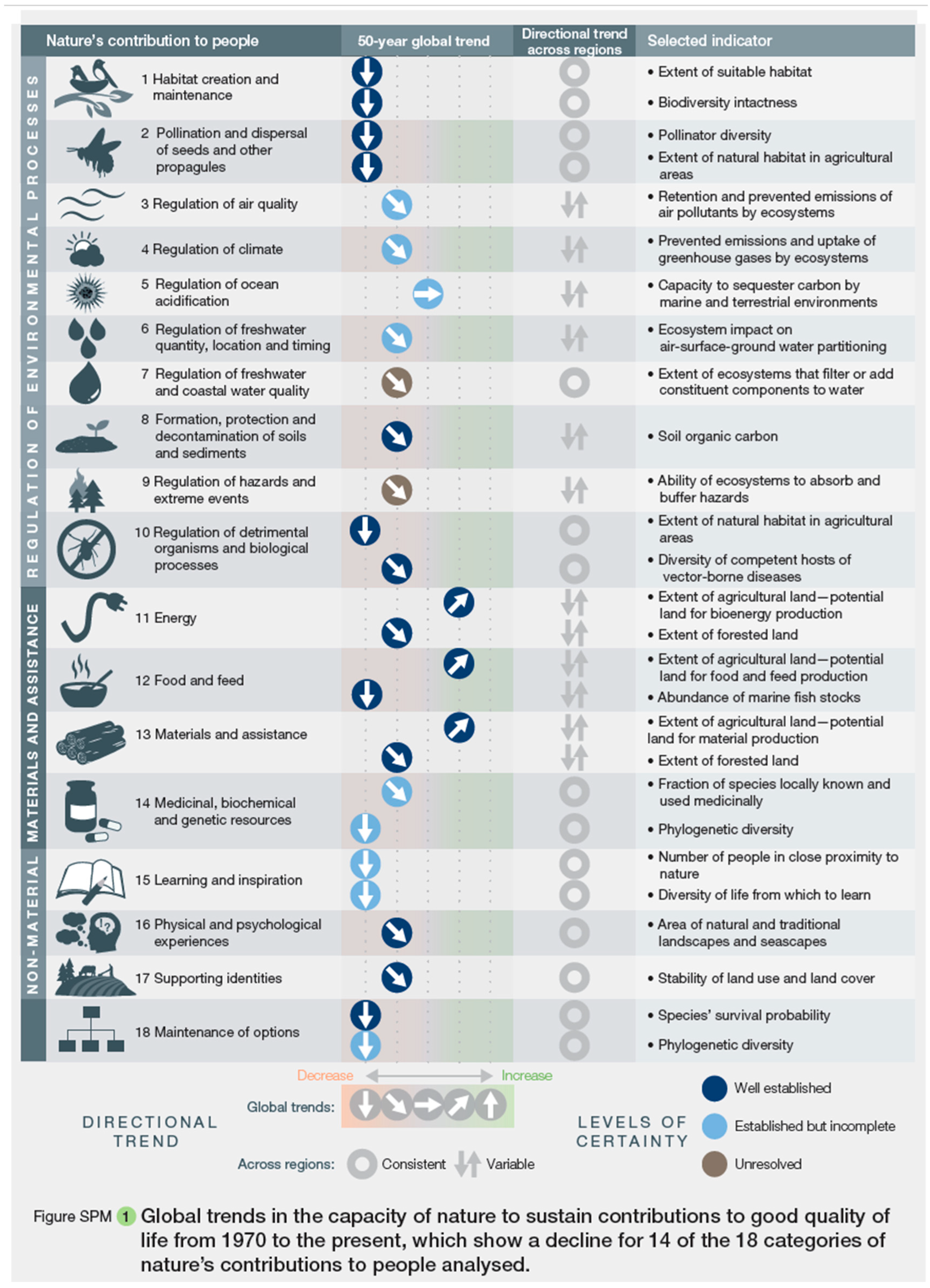
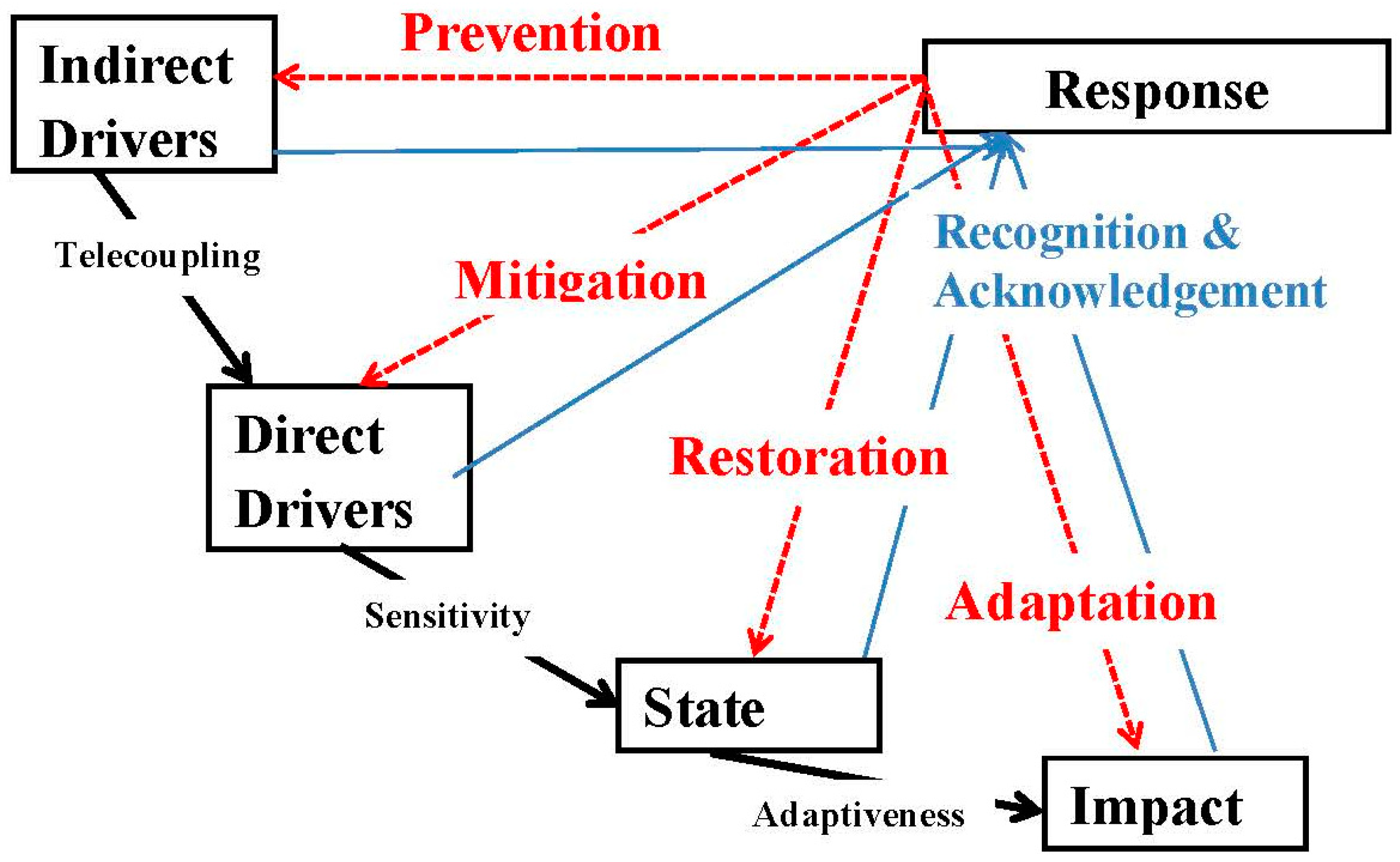
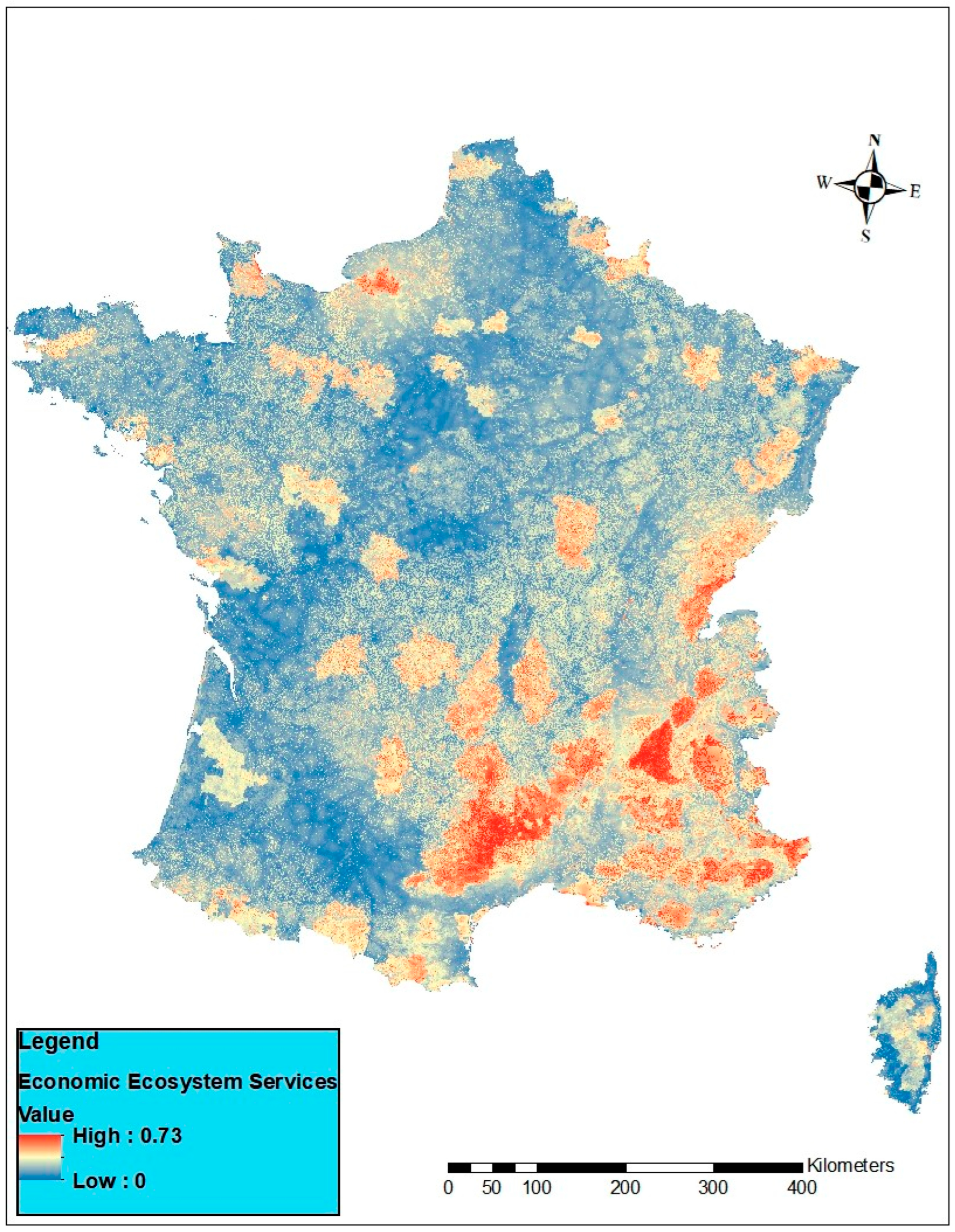
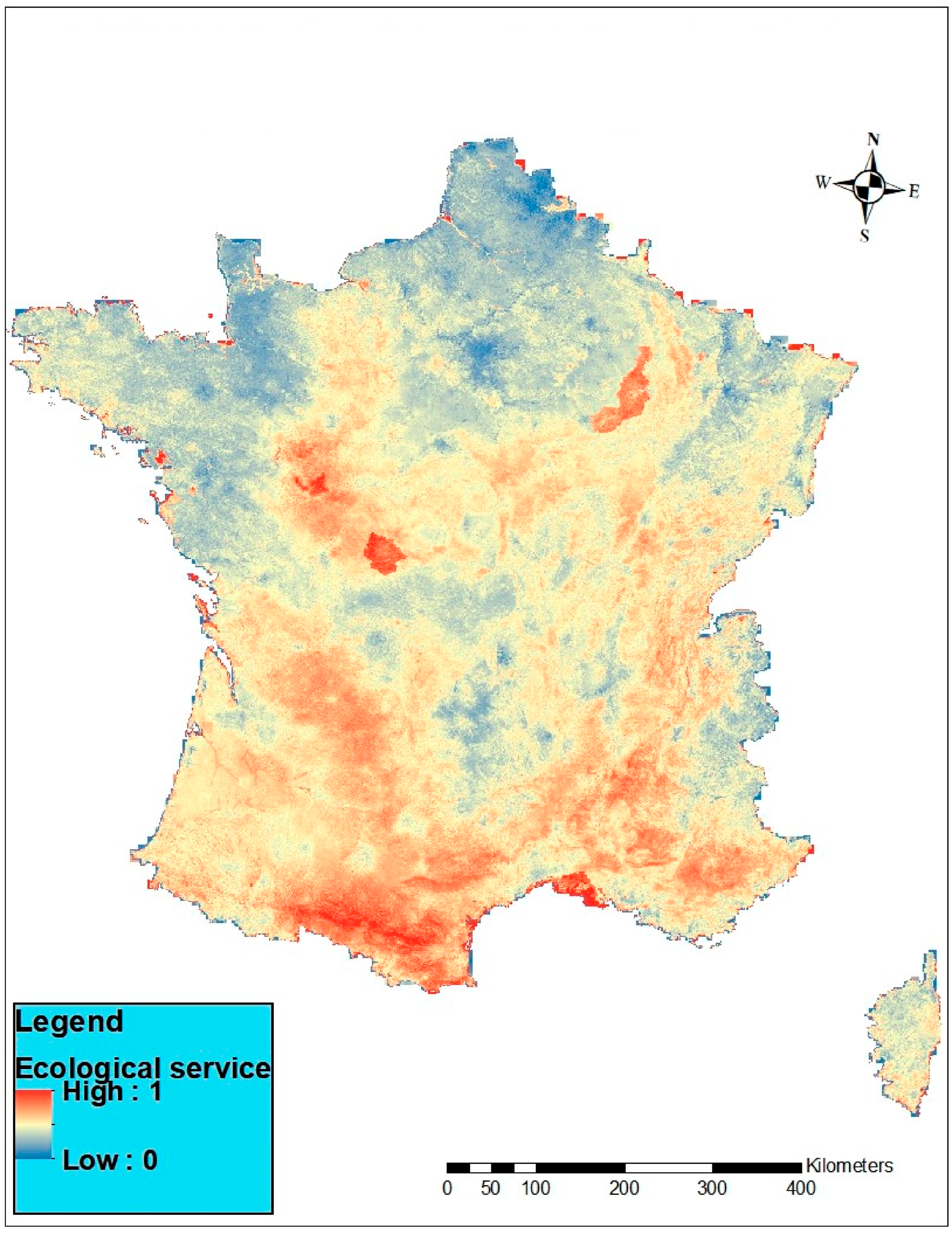
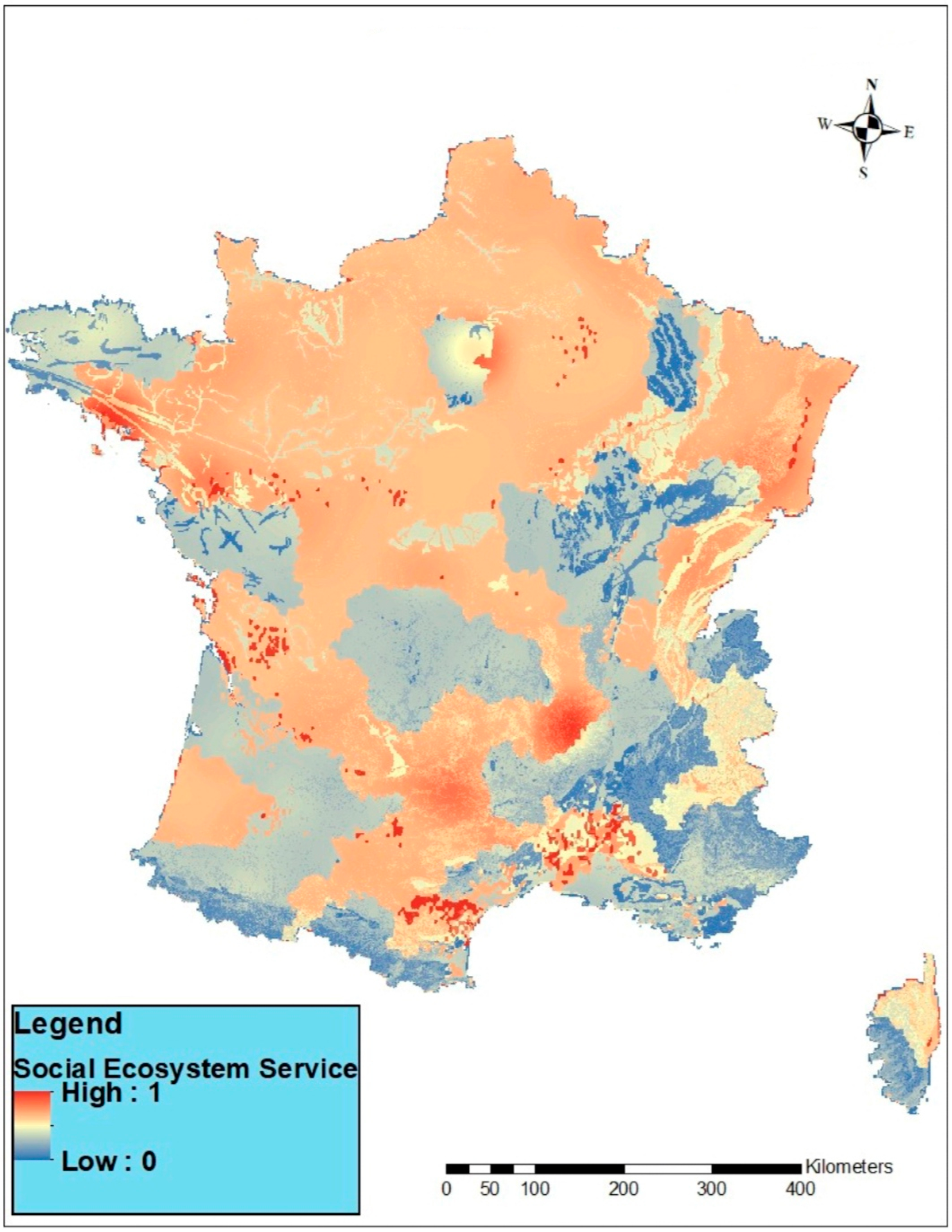
| Type of ESs/NCPs | ESs/NCPs | MA (2005) | TEEB (2010) | EFESE (2017) | CICES (2018) | IPBES (2019) |
|---|---|---|---|---|---|---|
| Provisioning | Fresh water | |||||
| Crops, including food and feed | ||||||
| Livestock | ||||||
| Aquaculture and fisheries | ||||||
| Wild terrestrial and aquatic animals and plants used for nutrition | ||||||
| Timber | ||||||
| Fibers, including cotton, hemp, silk etc | ||||||
| Bioenergy, biofuels, firewood | ||||||
| Biochemicals, natural medicines, pharmaceuticals | ||||||
| Type of ESs/NCPs | ESs/NCPs | MA (2005) | TEEB (2010) | EFESE (2017) | CICES (2018) | IPBES (2019) |
| Regulation and maintenance | Climate and microclimate regulation | |||||
| Air quality regulation, reduction of nuisance and odor | ||||||
| Water purification (fresh and coastal) and waste treatment | ||||||
| Water flow regulation | ||||||
| Formation, protection and decontamination of soils and sediments, erosion moderation/prevention | ||||||
| Biological pest control | ||||||
| Pollination and dispersal of seeds | ||||||
| Natural hazard and disease regulation | ||||||
| Maintenance of genetic diversity | ||||||
| Habitat creation and maintenance | ||||||
| Regulation of ocean acidification | ||||||
| Supporting soil quality and fertility, nutrient cycling | ||||||
| Type of ESs/NCPs | ESs/NCPs | MA (2005) | TEEB (2010) | EFESE (2017) | CICES (2018) | IPBES (2019) |
| Socio- cultural significance | Spiritual and religious values | |||||
| Aesthetic values | ||||||
| Biological infrastructure for recreation and ecotourism | ||||||
| Physical and psychological experiences for learning, inspiration, education and knowledge | ||||||
| Goods and products from ecosystems at heritage value | ||||||
| Stability of land use and land cover, supporting identities | ||||||
| Maintenance of options for the future |
Disclaimer/Publisher’s Note: The statements, opinions and data contained in all publications are solely those of the individual author(s) and contributor(s) and not of MDPI and/or the editor(s). MDPI and/or the editor(s) disclaim responsibility for any injury to people or property resulting from any ideas, methods, instructions or products referred to in the content. |
© 2023 by the authors. Licensee MDPI, Basel, Switzerland. This article is an open access article distributed under the terms and conditions of the Creative Commons Attribution (CC BY) license (https://creativecommons.org/licenses/by/4.0/).
Share and Cite
Shmelev, S.E.; Agbleze, L.; Spangenberg, J.H. Multidimensional Ecosystem Mapping: Towards a More Comprehensive Spatial Assessment of Nature’s Contributions to People in France. Sustainability 2023, 15, 7557. https://doi.org/10.3390/su15097557
Shmelev SE, Agbleze L, Spangenberg JH. Multidimensional Ecosystem Mapping: Towards a More Comprehensive Spatial Assessment of Nature’s Contributions to People in France. Sustainability. 2023; 15(9):7557. https://doi.org/10.3390/su15097557
Chicago/Turabian StyleShmelev, Stanislav E., Linus Agbleze, and Joachim H. Spangenberg. 2023. "Multidimensional Ecosystem Mapping: Towards a More Comprehensive Spatial Assessment of Nature’s Contributions to People in France" Sustainability 15, no. 9: 7557. https://doi.org/10.3390/su15097557
APA StyleShmelev, S. E., Agbleze, L., & Spangenberg, J. H. (2023). Multidimensional Ecosystem Mapping: Towards a More Comprehensive Spatial Assessment of Nature’s Contributions to People in France. Sustainability, 15(9), 7557. https://doi.org/10.3390/su15097557







